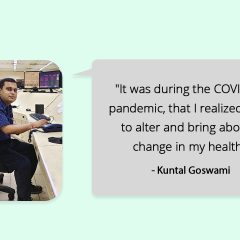 “Doctor please help! Half of my body does not move anymore” came a slurry cry from a helpless Vinod Agrawal, a businessman. His wife stood next to him in the emergency department weeping profusely and their 16 year old son watched his parents helplessly.
“Doctor please help! Half of my body does not move anymore” came a slurry cry from a helpless Vinod Agrawal, a businessman. His wife stood next to him in the emergency department weeping profusely and their 16 year old son watched his parents helplessly.
When examined thoroughly, Agrawal was diagnosed with STROKE. Thanks to the lifestyles that most people lead these days, this is a common site in hospitals.
A stroke strikes when the blood supply to the brain is affected either due to blockage leading to ischemia or rupturing of vessels. Due to this the brain does not receive enough oxygen and nutrition causing cell death, which is the ideal condition for stroke.
How Does a Stroke Happen?
- Ischemia: Occurs due to narrowing or blockage of blood vessels due to blood clots formed either in arteries connecting brains or other vessels or due to dislodgment of fatty deposits called plaques (atherosclerosis).
- Haemorrhagic: Bursting or leaking of blood vessels which compresses the brain cells. This leakage of blood puts pressure on brain cells which is accumulated in brain due to trauma, hypertension or some blood thinning medication.
- TIA- Transient Ischemic Attack (Mini Stoke): Brief episodes of stroke which is self-limiting. Blood flow is briefly interrupted and these are the warning signs of future stroke. It is like an alarm from the body.
Common Presentation of Stroke
- Weakness or tingling in half or full body depending on the involved artery
- Deviation of face with difficulty in speech and closure of one eye
- Mental Confusion, severe headache, loss of power in the limbs
When any of the above symptoms are seen, the patient must be rushed to the hospital.

After thoroughly understanding the history and general examination, few specific tests and examination like CT scan are done to find out the cause of the stroke. The treatment is very complicated and management is done in ICU and Neuro-physician may be required.
As there are two major causes of stroke – ischemia and haemorrhage – both have different management.
- If ischemic– the focus is to restore adequate blood flow-clot is broken or dissolved.
- If haemorrhagic -stop bleeding or leakage of blood, to reduce the pressure of brain cells. Surgical intervention may be required if there is any arterial malformation or rupture of vessels.
Rehabilitation activities like physiotherapy, speech therapy, etc. help to restore physical activities gradually.
Prevent It!
All the above symptoms and complications can be prevented if a healthy lifestyle is followed.
- Eat a healthy- diet which includes fresh fruits, vegetables, avoiding processed meat and avoid junk food.
- Yoga, especially Pranayama, ensures that every cell of the body receives adequate oxygen for appropriate functioning. Pranayama rejuvenates the body cells which ensures the ideal functioning of the body.
- Stress kills! Accept what life offers happily and keep working towards your goal without killing yourself.
- Remember Smoking Kills – all advertisements shown are true. STOP smoking.
- Avoid alcohol, if you do consume it, make it minimal.
- If you are hypertensive, keep an absolute check on blood pressure and follow all dietary and physical discipline so that blood pressure is controlled.
- If one is diabetic, regular check of sugar is important.
Listen to your body. It always warns you before the disease sets in.
Stroke is an acute emergency but the root cause lies in chronic habits and patterns of life. Every moment, even at this moment of reading the blog, we can choose health or disease. Either you choose to pick up alarming signals of body and employ the necessary preventive measures to live a healthy life or be undisciplined and get hospitalized. THE CHOICE IS YOURS!
We hope this article helps you. For more on stroke and prevention, check out Healthy Reads or ask a GOQii Coach for guidance by subscribing for personalized coaching here: https://goqiiapp.page.link/bsr
#BeTheForce



